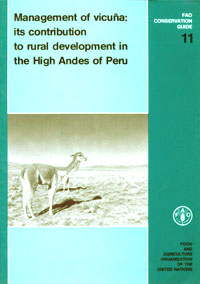Management of vicuña: its contribution to rural development in the High Andes of Peru

1.5 Economic returns from vicuña
1.5.1 Direct returns
1.5.2 Indirect returns
3.1 National and departmental objectives
3.2 Campesino communities and the Vicuña Project
3.2.1 Areas providing grazing for vicuña
3.2.2 Agreements with the campesino communities for use of grazing
3.2.3 Aims of the project in relation to the campesino communities
3.2.4 Basic concepts of the project
3.2.5 Productivity of the vicuña and domestic animals
4.1 Experience gained from the project
4.1.1 Achievements
4.2 Problems encountered in the management of this resource
4.2.1 Poaching and its control
4.2.2 Administration of the resource
4.2.3 Distribution of benefits to campesino communities
4.2.4 Budgetary constraints
4.2.5 Relations with other organizations
4.2.6 Marketing of the products